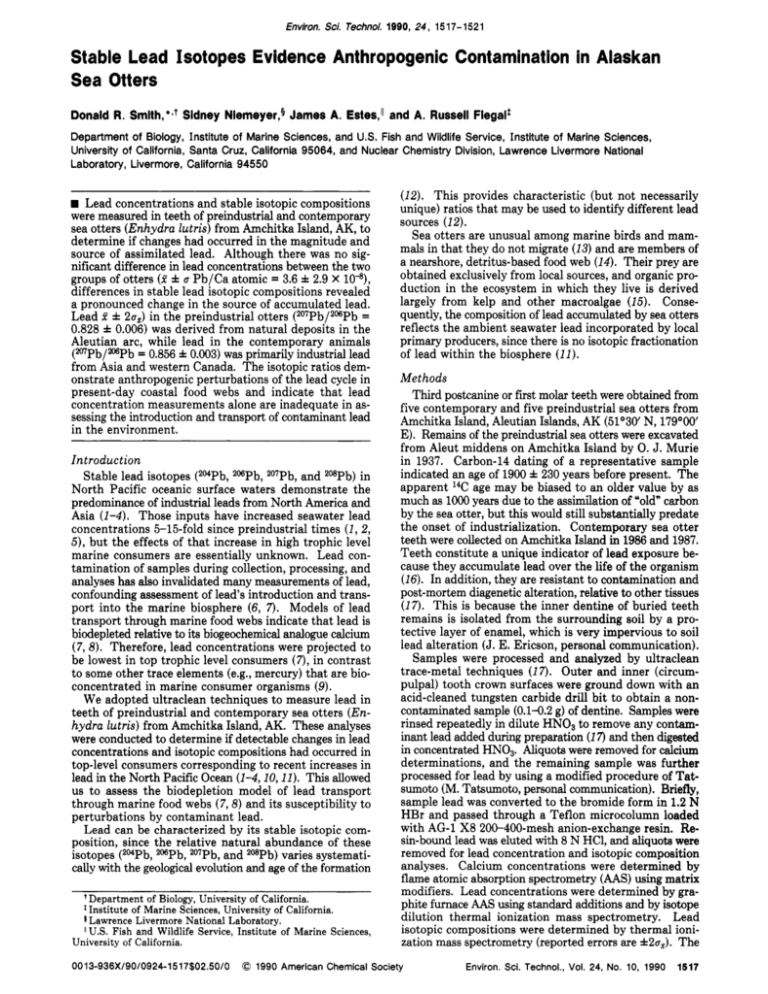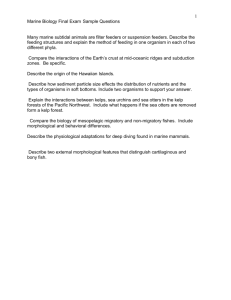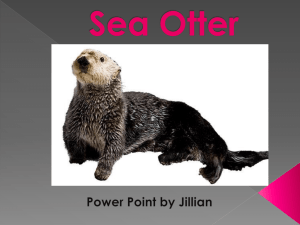Stable Lead Isotopes Evidence Anthropogenic Contamination in
advertisement

Environ. Sci. Technol. 1990, 24, 1517-1521 Stable Lead Isotopes Evidence Anthropogenic Contamination in Alaskan Sea Otters Donald R. Smlth,+*tSldney Niemeyer,§James A. Estes," and A. Russell Flegalt Department of Biology, Institute of Marine Sciences, and U.S. Fish and Wildlife Service, Institute of Marine Sciences, University of California, Santa Cruz, California 95064, and Nuclear Chemistry Division, Lawrence Livermore National Laboratory, Livermore, California 94550 Lead concentrations and stable isotopic compositions were measured in teeth of preindustrial and contemporary sea otters (Enhydra lutris) from Amchitka Island, AK, to determine if changes had occurred in the magnitude and source of assimilated lead. Although there was no significant difference in lead concentrations between the two groups of otters (f f u Pb/Ca atomic = 3.6 f 2.9 X differences in stable lead isotopic compositions revealed a pronounced change in the source of accumulated lead. Lead f f 2u,) in the preindustrial otters (207Pb/206Pb = 0.828 f 0.006) was derived from natural deposits in the Aleutian arc, while lead in the contemporary animals PPb/206pb = 0.856 f 0.003) was primarily industrial lead from Asia and western Canada. The isotopic ratios demonstrate anthropogenic perturbations of the lead cycle in present-day coastal food webs and indicate that lead concentration measurements alone are inadequate in assessing the introduction and transport of contaminant lead in the environment. Introduction Stable lead isotopes (204Pb,20BPb,207Pb,and 208Pb)in North Pacific oceanic surface waters demonstrate the predominance of industrial leads from North America and Asia (1-4). Those inputs have increased seawater lead concentrations 5-15-fold since preindustrial times (1, 2, 5),but the effects of that increase in high trophic level marine consumers are essentially unknown. Lead contamination of samples during collection, processing, and analyses has also invalidated many measurements of lead, confounding assessment of lead's introduction and transport into the marine biosphere (6, 7). Models of lead transport through marine food webs indicate that lead is biodepleted relative to its biogeochemical analogue calcium (7,8). Therefore, lead concentrations were projected to be lowest in top trophic level consumers (7), in contrast to some other trace elements (e.g., mercury) that are bioconcentrated in marine consumer organisms (9). We adopted ultraclean techniques to measure lead in teeth of preindustrial and contemporary sea otters (Enhydra lutris) from Amchitka Island, AK. These analyses were conducted to determine if detectable changes in lead concentrations and isotopic compositions had occurred in top-level consumers corresponding to recent increases in lead in the North Pacific Ocean (1-4,10,11). This allowed us to assess the biodepletion model of lead transport through marine food webs (7,8) and its susceptibility to perturbations by contaminant lead. Lead can be characterized by its stable isotopic composition, since the relative natural abundance of these isotopes (204Pb,206Pb,207Pb,and 208Pb)varies systematically with the geological evolution and age of the formation Department of Biology, University of California. * Institute of Marine Sciences, University of California. 8 Lawrence Livermore National Laboratory. U.S. Fish and Wildlife Service, Institute of Marine Sciences, University of California. '1 0013-936X/90/0924-1517$02.50/0 (12). This provides characteristic (but not necessarily unique) ratios that may be used to identify different lead sources (12). Sea otters are unusual among marine birds and mammals in that they do not migrate (13) and are members of a nearshore, detritus-based food web (14). Their prey are obtained exclusively from local sources, and organic production in the ecosystem in which they live is derived largely from kelp and other macroalgae (15). Consequently, the composition of lead accumulated by sea otters reflects the ambient seawater lead incorporated by local primary producers, since there is no isotopic fractionation of lead within the biosphere (11). Methods Third postcanine or first molar teeth were obtained from five contemporary and five preindustrial sea otters from Amchitka Island, Aleutian Islands, AK (51'30' N, 179'00' E). Remains of the preindustrial sea otters were excavated from Aleut middens on Amchitka Island by 0. J. Murie in 1937. Carbon-14 dating of a representative sample indicated an age of 1900 f 230 years before present. The apparent 14Cage may be biased to an older value by as much as lo00 years due to the assimilation of "old" carbon by the sea otter, but this would still substantially predate the onset of industrialization. Contemporary sea otter teeth were collected on Amchitka Island in 1986 and 1987. Teeth constitute a unique indicator of lead exposure because they accumulate lead over the life of the organism (16). In addition, they are resistant to contamination and post-mortem diagenetic alteration, relative to other tissues (17). This is because the inner dentine of buried teeth remains is isolated from the surrounding soil by a protective layer of enamel, which is very impervious to soil lead alteration (J. E. Ericson, personal communication). Samples were processed and analyzed by ultraclean trace-metal techniques (17). Outer and inner (circumpulpal) tooth crown surfaces were ground down with an acid-cleaned tungsten carbide drill bit to obtain a noncontaminated sample (0.1-0.2 g) of dentine. Samples were rinsed repeatedly in dilute HN03 to remove any contaminant lead added during preparation (I7) and then digested in concentrated HNO,. Aliquota were removed for calcium determinations, and the remaining sample was further processed for lead by using a modified procedure of Tatsumoto (M. Tatsumoto, personal communication). Briefly, sample lead was converted to the bromide form in 1.2 N HBr and passed through a Teflon microcolumn loaded with AG-1 X8 200-400-mesh anion-exchange resin. Resin-bound lead was eluted with 8 N HC1, and aliquota were removed for lead concentration and isotopic composition analyses. Calcium concentrations were determined by flame atomic absorption spectrometry (AAS)using matrix modifiers. Lead concentrations were determined by graphite furnace AAS using standard additions and by isotope dilution thermal ionization mass spectrometry. Lead isotopic compositions were determined by thermal ionization mass spectrometry (reported errors are *2a,). The 0 1990 American Chemical Society Environ. Sci. Technol., Vol. 24, No. 10, 1990 1517 Table I. Concentrations and Isotopic Compositions of Lead in Teeth of Sea Otters from Amchitka Island, AI(, Isotopic Compositions of Aleutian Arc Rocks, and Industrial Inputs to the Eastern and Western North Pacific Ocean" PbICa, isotopic composition Pb, nglg of dry w t X10" atomic 2061204 2071204 2081204 19 14 72 61 48 49 61 1.3 0.95 5.0 4.6 3.4 3.3 4.2 18.94 (0.36) 19.08 (0.45) 18.63 (0.09) 18.61 (0.08) 18.76 (0.18) 18.75 (0.13) 18.78 (0.19) 15.64 (0.16) 15.69 (0.20) 15.52 (0.04) 15.54 (0.04) 15.60 (0.08) 15.56 (0.08) 15.53 (0.20) 38.60 (0.62) 38.74 (0.76) 38.15 (0.16) 38.16 (0.14) 38.39 (0.32) 38.34 (0.24) 38.63 (0.48) 0.8254 0.8218 0.8334 0.8348 0.8312 0.8277 0.8242 (0.0088) (0.0106) (0.0022) (0.0018) (0.0042) (0.0034) (0.0046) 2.042 (0.013) 2.035 (0.015) 2.049 (0.004) 2.052 (0.003) 2.048 (0.007) 2.044 (0.005) 2.038 (0.014) 130 42 140 23 25 26 1.7 2.4 9.5 1.1 1.2 1.3 18.13 (0.05) 18.95 (0.10) 18.21 (0.07) 18.28 (0.10) 18.18 (0.10) 18.28 (0.12) 15.59 (0.04) 15.67 (0.05) 15.61 (0.04) 15.60 (0.05) 15.56 (0.05) 15.57 (0.06) 38.13 (0.08) 38.62 (0.18) 38.18 (0.14) 38.21 (0.18) 38.05 (0.20) 38.07 (0.22) 0.8596 (0.0030) 0.8271 (0.0024) 0.8574 (0.0018) 0.8539 (0.0026) 0.8535 (0.0024) 0.8516 (0.0032) 2.104 (0.004) 2.039 (0.004) 2.098 (0.004) 2.091 (0.005) 2.089 (0.005) 2.084 (0.006) natural sources Aleutian arc (n = 24) (33) 18.84 (0.15) 15.57 (0.05) 38.39 (0.24) 0.8269 (0.0051) 2.038 (0.008) industrial inputs Asia/Japan (n = 3)* Western Canada (1) ., Western U.S. (40) 17.95 (0.14) 18.42 19.3 15.42 (0.26) 15.83 15.8 38.04 (0.16) 38.18 38.9 0.8593 (0.0140) 0.8595 0.820 2.129 (0.022) 2.073 2.02 sea otter teeth 2071206 208/206 preindustrial 1 2 3a** 3b** 4 5a** 5b** contemporary 1 2 3 4a* 4b* 5 "Redicate samDles from a common tooth (*) or mandible (**). Errors in parentheses are 2a,. bM.Morozumi, personal communication. fractionation correction for the latter analyses, which were derived from concurrent calibrations of SRM 981, was 0.12 f 0.02%. Total cumulative lead blanks were <150 pg, based on the analyses of container, reagent, and procedural blanks. All reagents and containers (conventional polyethylene or Teflon) were prepared with the ultraclean procedures detailed by Patterson and Settle (18). Lead concentrations are normalized to calcium since lead serves as a biologic analogue to calcium. Lead is transported intracellularly by essentially the same routes, and it is controlled by many of the same mechanisms responsible for maintaining calcium homecatasis in living systems (19). A total of 70-95% of a vertebrate's body lead burden is localized in the skeletal tissue (20,21),where concentrations increase with age and level of exposure to lead (22-24). Osseous tissue trace-element concentrations presented on a wet or dry weight basis can introduce analytical error and confound comparisons between samples due to differences in both mineral and nonmineral content between skeletal tissues and individuals sampled (25). Results and Discussion Sea otter lead burdens (expressed as R f Q Pb/Ca atomic ratios) have not increased significantly ( P > 0.05,t test) relative in the contemporary sea otters (4.4f 3.9 X to their preindustrial counterparts (2.8 f 1.6 X lo4) based on this preliminary sampling (Table I). This contrasts with measured order of magnitude increases in lead reported for western North Atlantic corals (26) and for humans (In,and similar estimated increases for pelagic tuna (6,27) and for a remote terrestrial subalpine carnivore (28). Those increases are attributed to atmospheric emissions of anthropogenic lead (3 X lo8 kg year-'), which are currently nearly 2 orders of magnitude greater than natural emissions (5, 29). The absence of a significant increase in the Pb/Ca ratio of the contemporary sea otters compared to their preindustrial counterparts is attributed to the relatively small increase of lead in remote oceanic regions and the biodepletion of lead in marine food webs (Figure 1) (7,8). Lead is passively enriched relative to calcium during the transfer 1518 Environ. Sci. Technol., Vol. 24, No. 10, 1990 IC -5 I I Seawater ' I Herbivore Algae Carnivore Figure 1 . Biodepletion of lead in a simple coastal marine food web, in which a 10-fold increase in the Pb/Ca (atomic) of seawater is attenuated to a 2-fold increase in the Pb/Ca of a carnivore. Mean Pb/Ca (vertical bars are ranges) of preindustrial )(. and contemporary (0)sea otters from this study are included for reference. This scheme is extrapolated from data of Burnett and Patterson (a),Michaels and Flegal (7), and this study. of these elements from seawater to plants because lead is more strongly chelated on plant surfaces than is calcium, and because algae have a large surface area/volume ratio (7,8). Lead is then biodepleted relative to calcium during subsequent transfers to consumer organisms (8, 27) because of a discrimination against lead in favor of calcium during the metabolic assimilation of these elements (8). The transfer of lead relative to calcium from seawater through the marine food web is nonlinear, and the biodepletion of lead apparently operates independently of the lead concentrations of food when they are within 100-fold of natural levels (8). This is evidenced in a simple coastal food web, where a 5-fold increase in Pb/Ca of food (algae) of a gastropod resulted in only a 3-fold increase in the Pb/Ca of its shell, and only a 50% increase in the Pb/Ca of its muscle (8). The within group between sample variance is primarily attributed t o individual differences in the accumulation 2'161 2.12 0 0 0 a -00.2 0.830 0.810 0.850 0.870 207Pb/206Pb 15.9 b v 15.81 15.71 1541 15.31' 17.8 rD 0 I 18.2 18.6 19.0 19.4 206Pb/204Pb (a) "FblmPb vs -b/=Pb and (b) =Pbl-b vs of preinduskkd (.)and mntemporaty (0)sea otters from Amchltka Island, AK. Error bars In (a)are *2aX. Error bars In (b) were omitted lor h r i t y , a m h y wwe tvpicruv M . 5 X the symbol diameter for the contemporary sea otters and *4X the symbol diam eter for the preindustrial sea otters. Lead isotopic compositlons of natural and anthropogenic sources are plotted for comparison: (0) natural Aleutian arc lead (33):(0) Japanese industrial lead (M. Morozumi, personal communication):(A)western Canada industrial lead ( 1 ) : (V)western United States Industrial lead (40). The Northern Hemisphere reference line (---) ( 4 1 ) Is Included In (b) for reference. Flgure 2. "'PblmPb of lead due to otter age and diet. Lead exposure duration is a function of age, and lead exposure concentration is a function of diet. The effect of the latter variable on sea otter lead levels is illustrated by the lead hiodepletion model (refs 7 and 8, Figure 1). This predicts that prey species occupying higher trophic levels will be more depleted of lead relative to calcium than lower trophic level organisms. Sea otters have highly individualized diets (30), and in addition to the typical prey of benthic invertebrates, sea otters at Amchitka Island consume kelp bed fishes. The extent of this piscivory also varies among individuals (31). Because most of the benthic invertebrates eaten by sea otters are herbivores (mainly sea urchins), the invertebrate feeders are essentially secondary consumers. However, since fish feed chiefly on a wide range of berhivorous, carnivorous, and detritivorous crustaceans (321, piscivorous sea otters are tertiary consumers or higher. Although there has been no detectable increase in the lead content of contemporary sea otters, lead isotopic composition analyses indicate substantial changes in the source of lead in those animals. The lead isotopic ratios (Figure 2a,b) demonstrate that natural leads from the Aleutian arc (33)account for essentially all of the lead in preindustrial sea otters. The natural lead component is presumed to arise primarily from weathering of plioPleistocene volcanic rocks in the Aleutian volcanic arc, with subsequent alluvial deposition along the coastal margin. The Aleutian arc lavas have distinct and contrasting lead isotopic compositions compared to volcanic rocks of the Pacific Ocean crust or the nearby Pribilof Islands (33), supporting the presumption of a primarily local (Aleutian arc) source of the natural lead assimilated by Amchitka Island sea otters. Contemporary otters, in contrast, contain a mixture of Asian and Canadian industrial leads, with relatively minor amounts (<lo%) of Aleutian arc leads. Asian industrial lead (207Pb/206Ph = 0.859 i 0.007, 208Pb/206Pb = 2.12 0.01) (M. Morozumi, personal communication) is introduced to waters of the Kurosbio current via aeolian deposition and transported across the North Pacific to the * muro 3. Lead M)urct)s to Amchltka Island sea otters (mPb/mPb ratios). Leads in !he prelnduS!rial Otters (2.04) were derived from ~ a t t m l weamerlnp of the Aleutian arc iavas (2.04). In contrast, leads in the contemporaty otters (2.09) were derived primariiy from Asian (left arrow, 2.12) and wastern Canadian (right arrow, 2.07) lndusbial leads that were introduced into ocean surface waters via aeolian depositlon. Envlron. Sci. Technol.. Vol. 24. No. 10, t990 l5lB Alaska Current (2-4). The Alaska Current skirts western North America, where it may entrain Canadian industrial = 0.860, 208pb/206Pb= 2.07) ( I ) , and then lead (207Pb/206Pb flows westward along the Aleutian arc as the Alaskan Stream (Figure 3) (34). Therefore, the isotopic composition of lead in contemporary otters is consistent with those of surface waters in the northeast Pacific Ocean, and with the projected dispersion of industrial lead aerosols. Lead isotopic values within the preindustrial and contemporary sample groups are generally not significantly different ( P > 0.05, t test) because of the large errors calculated for most ratios. Those errors are dominated by the analytical blank correction (117 f 58 pg of Pb; 206pb/200Pb= 18.08 f 1.88,mPb/204Pb= 15.27 f 0.82, and 208Pb/2arPb= 37.18 f 3.22), while the measured isotopic ratios were essentially unchanged. Use of this pooled blank, and propagation of its large error (35),was considered the most conservative approach. Typical measurement errors (f2u,) for 206Pb/204Pb, zo7Pb/204Pb, and 208Pb/204Pb ratios were <f0.20% of the mean, while the errors on the more precise 207Pb/206Pb and 208Pb/206Pb ratios were <f0.08%. After propagation of the pooled blank error value, the errors as reported were increased to approximately f0.65 and f0.38%, respectively. However, even these inflated errors do not preclude differentiation between leads accumulated by the contemporary and preindustrial sea otters. United States industrial lead does not appear to measurably contribute to the lead isotopic compositions of the contemporary sea otters (Table I, Figure 2a,b). One possible exception to this is contemporary sea otter sample 2, which contains an isotopic composition closer to U S . industrial lead, but most like the natural Aleutian arc leads. We have no explanation for this anomaly, other than to suggest it may be due to the intake of US. industrial lead and/or natural lead in the diet of the animal. This latter alternative is partly substantiated by the near identical lead isotopic composition of contemporary and preindustrial walrus teeth collected from animals that inhabited the St. Lawrence Island and southern Chukchi Sea regions (D. Smith, unpublished data). The isotopic composition of those preindustrial (206Pb/*Pb = 18.94 f 0.02, zo7Pb/204Pb = 15.62 f 0.02, 208Pb/zo4Pb= 38.71 f 0.06) and contemporary (2MPb/204Pb= 18.95 f 0.02, zo7Pb/204Pb = 15.61 f 0.02, zo8Pb/204Pb= 38.67 f 0.06) samples is similar to the natural Aleutian arc leads and to North American continental detritus leads (206Pb/204Pb = 18.98 f 0.20, 207Pb/2arPb= 15.63 f 0.04, 208Pb/204Pb = 38.79 f 0.26) (36). The absence of a change in lead isotopic composition between the preindustrial and contemporary walruses is attributed to the ingestion of relatively large amounts of natural sediment lead by those animals, who feed mainly on benthic invertebrates. The exchange of soil lead is not considered to have significantly altered the lead composition of the preindustrial teeth. This is based on analogies with analyses by Ericson et al. (17), who reported minimal diagenetic alteration of tooth enamel of buried ancient Peruvian remains. The present analyses were also limited to dentine, which was physically isolated from the surrounding environment. These sea otter data are relevant to concerns of lead toxicity because they demonstrate low lead levels and little or no postindustrial lead increase in a higher trophic level marine consumer. For comparison, levels reported here are 40-400-fold lower than those in teeth of children of the low-lead exposure group in a landmark study of asymptomatic lead toxicity (37). This does not eliminate cause 1520 Environ. Sci. Technol., Vol. 24, No. 10, 1990 for concern of lead contamination in marine mammals, since there may be no lower threshold concentration of lead toxicity (38). Additionally, analysis of contemporary sea otters from more industrialized regions is warranted, since the lead biodepletion process in marine mammals may be less efficient than in terrestrial mammals, for which the toxicity of lead is relatively well-known (39). In summary, these data demonstrate that lead isotope systematics should be used to identify sources and transport routes of lead in the marine biosphere. If only lead concentrations had been determined in these sea otter teeth, it would have been incorrectly concluded that there was no measurable change in the lead accumulated by contemporary animals since preindustrial times. Finally, these data provide a means of deriving the occurrence of natural leads in the prehistoric oceans of high-latitude regions where there are no suitable calcite-containing macroinvertebrates. Acknowledgments We are indebted to C. C. Patterson, who pioneered the theoretical and trace-metal-clean techniques that made this research possible. We are grateful to the University of Alaska Museum, Fairbanks, AK, for supplying the preindustrial sea otter teeth, and to the United States Fish and Wildlife Service for the contemporary teeth. This manuscript benefited from comments by Gary Gill and William Glaze. Literature Cited Stukas, V. J.; Wong, C. S.Science (Washington,D.C.) 1981, 21 I , 1424-1427. Flegal, A. R.; Patterson, C. C. Earth Planet. Sci. Lett. 1983, 64, 19-32. Flegal, A. R.; Duda, T. F.; Niemeyer, S. Nature (London) 1989, 339,458-460. Flegal, A. R.; Itoh, K.; Patterson, C. C.; Wong, C. S. Nature (London) 1986,321,689-690. Patterson, C. C. Nature (London) 1987,326, 244-245. Settle, D. M.; Patterson, C. C. Science (Washington,D.C.) 1980, 207, 1167-1176. Michaels, A. F.; Flegal, A. R. Limnol. Oceanogr. 1990,35, 281-295. Burnett, M. W.; Patterson, C. C. In Isotope Marine Chemistry;Goldberg, E. D., Horibe, Y., Saruhashi,K., Eds.; Uchida Rokakuho: Tokyo, 1980; pp 413-438. Martin, J. H.; Elliott, P. D.; Anderlini, V. C.; Girvin, D.; Jacobs, S.A.; Risebrough, R. W.; Delong, R. L.; Gilmartin, W. G. Mar. Biol. 1976, 35, 91-104. Schaule, B. K.; Patterson, C. C. Earth Planet. Sci. Lett. 1981,54, 97-116. Flegal, A. R.; Stukas, V. J. Mar. Chem. 1987,22,163-177. Faure, G. Principles of Isotope Geology;J. Wiley & Sons: New York, 1986. Kenyon, K. W. North Am. Fauna 1969,68, 1-352. VanBlaricom, G. R., Estes, J. A., Eds. The Community Ecology of Sea Otters; Springer-Verlag: Berlin, 1988. Duggins, D. 0.; Simenstad, C. A.; Estes, J. A. Science (Washington, D.C.) 1989, 245, 170-173. Steenhout, A. Arch. Enuiron. Health 1982, 37,224-231. Ericson, J. E.; Shirahata, H.; Patterson, C. C. N . Engl. J. Med. 1979,300, 946-951. Patterson, C. C.; Settle, D. M. In Accuracy in Trace Analysis: Sampling, Sample Handling, and Analysis; National Bureau of Standards Special Publication 422; Proceedings of the 7th IMR Symposium, Gathersburg, Md; 1976; pp 321-351. Rosen, J. F.; Pounds, J. G. Toxicol.Appl. Pharmacol. 1989, 98, 530-543. Schroeder, H. A.; Tipton, I. H. Arch. Enuiron. Health 1968, 17, 965-978. Barry, P. S.I. Br. J . Ind. Med. 1975, 32, 119-139. Environ. Sci. Technol. 1990,24, 1521-1527 Gross, S. B.; Pfitzer, E. A.; Yeager, D. W.; Kehoe, R. A. Toxicol. Appl. Pharmacol. 1975,32,638-651. Steenhout, A,; Pourtois, M. Br. J. Ind. Med. 1981, 38, 297-303. Somervaille, L. J.; Chettle, D. R.; Scott, M. C.; Tennant, D. R.; McKiernan, M. J.; Skilbeck,A.; Trethowan, W. N. Br. J. Znd. Med. 1988,45, 174-181. Whittmers, L. E., Jr.; Wallgren, A.; Alich, A.; Aufderheide, A. C.; Rapp, G., Jr. Arch. Environ.Health 1988,43,381-391. Shen, G. T.; Boyle, E. A. Earth Planet. Sci. Lett. 1987,82, 289-304. Patterson, C. C.; Settle, D. M. Mar. Biol. 1977,39,289-295. Elias, R. W.; Hirao, Y.; Patterson, C. C. Geochim. Cosmochim. Acta 1982, 46, 2561-2580. Nriagu, J. 0.;Pacnya, J. M. Nature (London) 1988,333, 134-139. Lyons, K. J. M.S. Thesis, University of California,Santa Cruz, 1989. Estes, J. A,; Jameson, R. J.; Johnson, A. M. In The WorldwideFurbearer ConferenceProceedings; Chapman, J. A., Pursley, D., Eds.; Worldwide Furbearer Conference, Frostburg, MD, 1981; pp 606-641. Simenstad, C. A.; Isakson, J. S.; Nakatani, R. E. In The Environment of Amchitka Island; TID-26712;Merritt, M. L., Fuller, R. G., Eds.; NTIS, U.S. Dept. of Commerce: Springfield, VA, 1977; pp 451-492. (33) Kay, R. W.; Sun, S. S.; Lee-Hu, C. N. Geochim. Cosmochim. Acta 1978, 42, 263-273. (34) Favorite, F.; Dodimead, A. J.; Nasu, K. Int. North Pacific Fish. Comm. Bull. 1976, 33, 187. (35) Bevington, P. R. Data Reduction and Error Analysis for the Physical Sciences; McGraw-Hill: New York, 1969. (36) Church, S. E. Earth Planet. Sci. Lett. 1976,29, 175-188. (37) Needleman, H. L.; Gunnoe, C.; Leviton, A.; Reed, R.; Peresie, H.; Maher, C.; Barrett, P. N. Engl. J. Med. 1979, 300, 689-695. (38) National Academy of Sciences Lead in the Human Environment;National Academy Press: Washington, DC, 1980. (39) Patterson, C. C.; Shirahata, H.; Ericson, J. E. Sci. Total Environ. 1987, 61, 167-200. (40) Shirahata, H.; Elias, R. W.; Patterson, C. C.; Koide, M. Geochim. Cosmochim. Acta 1980,44, 149-162. (41) Hart, S. R. Nature (London)1984, 309,753-757. Received for review January 16,1990. Revised manuscript received May 7,1990. Accepted May 30,1990. This research was supported by the NSF (OCE-H612113), University of California Institute of Geophysics and Planetary Physics, the University of California Toxics Substances Research and Teaching Rogram, and the Minerals Management Service. Measurements of Nitrous Acid inside Two Research Houses Michael Brauer," P. Barry Ryan, Helen H. Suh, Petros Koutrakls, and John D. Spengler Department of Environmental Health, Harvard University, School of Public Health, 665 Huntington Avenue, Boston, Massachusetts 02 115 Nell P. Leslie Chamberlain GARD, 7449 North Natchez Avenue, Niles, Illinois 60648-3892 Irwin H. Bllllck Gas Research Institute, 8600 West Bryn Mawr Avenue, Chicago, Illinois 60631 Continuous analyzers for NO, NO2, and HONO were used to study the production and decay of these gases in two indoor air quality research houses, using unvented gas space heaters and ranges as combustion sources. In agreement with previous studies, indoor HONO concentrations were elevated during unvented combustion. Peak (15-min) levels up to 100 ppb HONO and 24-h averages as high as 40 ppb were measured. The observed kinetics suggest the secondary formation of HONO, possibly as a result of heterogeneous reactions involving NOz, in addition to primary production of HONO during combustion. Introduction The production of nitrogen dioxide and other nitrogen oxides in combustion processes has for some time been recognized as a potential indoor air quality problem. Research efforts have indicated that concentrations of NO2 indoors sometimes exceed outdoor concentrations in environments where unvented gas heating the cooking appliances are operating (1-6). Indoor concentrations are a function of both (indoor and outdoor) source and removal processes, such as air exchange, or chemical reactions. Several recent laboratory investigations have identified surface materials commonly present indoors that react with NO2to reduce concentrations (7-10).These studies have primarily been limited to measurements of the gases NOz and nitric oxide, and of nitrite and nitrate ions on the materials. One possible gaseous product of NOz reactivity 0013-936X/90/0924-1521$02.50/0 is nitrous acid. Preliminary results of one of these studies detected significant amounts of nitrous acid, probably resulting from heterogeneous reactions involving NO2 and the surface material (9). Although little information exists with respect to HONO toxicity and typical indoor concentrations, HONO has been well studied as a reactant in photochemical smog production (11,12). Photolysis of HONO (310 nm < X < 390 nm) has been recognized as a major source of hydroxyl radical in the early morning hours (13-15). Outdoor (15min average) HONO concentrations of 0.03-15.0 ppb have been measured, with the highest levels measured during predawn hours in heavily polluted urban areas. Typical outdoor concentrations in urban areas peak a t less than 5 ppb (11, 15-18). An important formation pathway is suspected to be the heterogeneous reaction of NO2 with water to produce both HNOBand HONO (19,20). 2N02 + H20 HONO + HN03 (1) Since a heterogeneous reaction mechanism for HONO production was thought to dominate in smog chambers and reaction vessel studies (21-231, Pitts and co-workers conjectured that NO2to HONO conversion would also occur in typical indoor environments, particularly in circumstances where indoor combustion appliances generated significant concentrations of NO2. In a preliminary study in a mobile laboratory, NOz was injected into the laboratory air and HONO concentrations increased with firstorder kinetics with respect to NO2,indicating the potential 0 1990 American Chemical Society -+ Environ. Sci. Technol., Vol. 24, No. 10, 1990 1521









